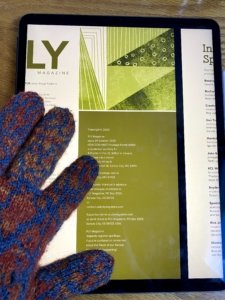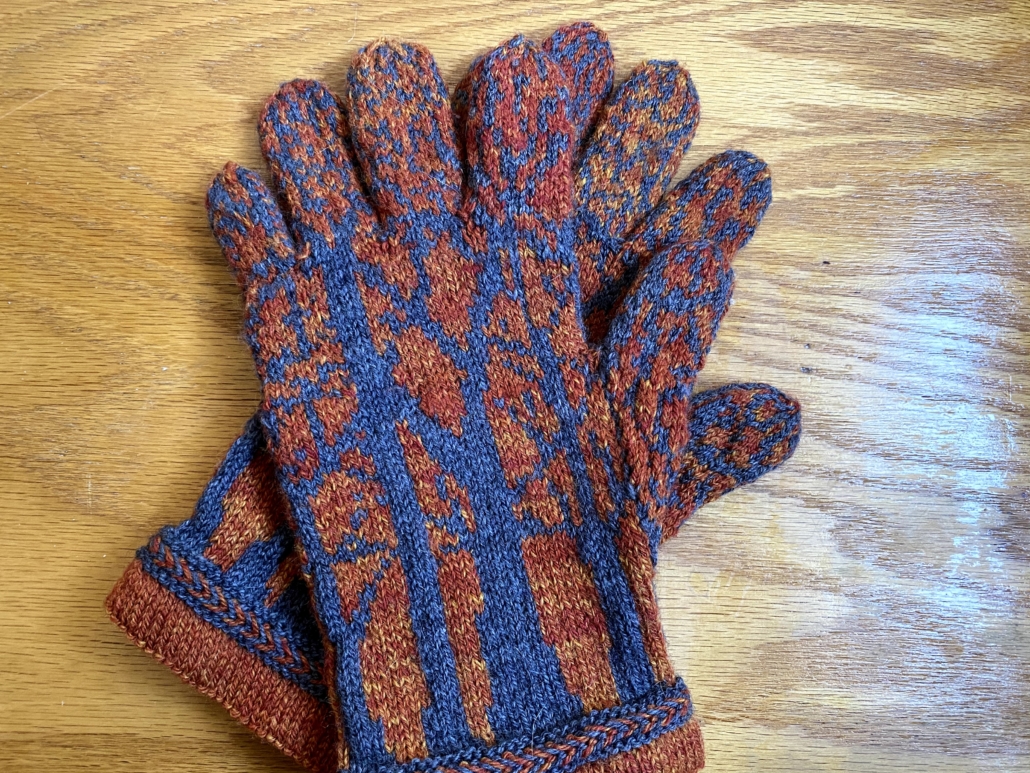Handspinning Touchscreen Gloves
words and photos by Christie Schulze
Alberta winters can be brutally cold, which makes having a good pair of mittens or gloves an absolute necessity. After trying several pairs of gloves claiming to be compatible with touchscreens that either did not work as advertised or were nowhere near warm enough (seriously, how am I supposed to scroll through Insta while waiting for the bus without losing a thumb to frostbite?), I decided that if I wanted touchscreen gloves, I would have to make my own.
I researched my fiber options. I found some conductive thread and purchased it with the intention of holding it double with my yarn when knitting the end of the fingers, but when it arrived it was much thicker than I realized – nearly the same size as my fingering weight yarn – and a light beige colour that was going to contrast significantly against my darker yarn. Thankfully, one of the great advantages to being a handspinner is being able to make exactly the yarn you need.
I took a closer look at the conductive thread to see how it was made. It appeared to be a metallic strand plied with cotton. I had stumbled across a listing for spinnable stainless steel fibre on Etsy some years back and bought it as a novelty. Knowing it was conductive, I started my experiments there.
A previous bad experience told me that I didn’t want to just spin the stainless steel by itself and ply it with my wool. I had previously worked with a commercial yarn made of two plies of wool and one of stainless steel. The yarn was lovely and looked amazing, but as I worked with it, the strand of stainless steel seemed like it was cutting through the wool. I had to splice that yarn with great frequency – and what was meant to be a gift for my mother-in-law to wear to my wedding ended up being finished closer to our third anniversary. I decided to try blending the stainless steel into wool.
As so often happens with my fibre arts experiments, I experimented on my partner first by making him a pair of gloves. In my defense, he had asked for a pair of gloves in orange and grey, which seemed perfect colour-wise for blending in some stainless steel. Plus, the fibre I had set aside for my own gloves was a limited edition colourway from a dyer no longer dyeing – I wasn’t about to experiment with that!
I blended the stainless steel into the grey shade of wool for the gloves. I had no idea what ratio I should start with for my blend, so I decided on an 80/20 wool/stainless steel blend, thinking anything higher than that for the stainless steel might noticeably impact the warmth. I weighed my fibres and blended the stainless steel with the wool using hand cards. I rolled my fibre so as to keep the fibres as parallel as possible to maintain consistency with the rest of the commercially prepared top. My first experiment was a success: I had a yarn that could be used with a touchscreen!
I blended enough to use for the forefinger and thumb of each glove. Next came the true experiment. I knew the grey stainless steel blend would work with a touchscreen on its own, but I wasn’t sure if it would work when combined with the orange in the colourwork pattern. I made a small swatch and … success again! When knit together in the pattern, the yarn maintained its touchscreen properties, and my partner was able to swipe through his phone in comfortable warmth.
It’s been about a year since I made those gloves, and they have held up to the Alberta winters. I also made a hat to match! As for my own gloves, they’re still in the queue. I’ll get to them right after I finish this shawl…
Fibre used:
Grey – 50/50 Merino/Corriedale commercial top from Hilltop Cloud in the Storm colourway, blended with 20% stainless steel fibre (purchased from Divinity Fibers)
Orange – 100% Corriedale commercial top from Ashford (purchased from Stash Lounge) in Orange, Pumpkin Pie, and Nutmeg colourways, blended on a hackle.
Pattern: Deep in the Forest Mittens by Tuulia Salmela, adapted to gloves by me.
Christie Schulze is a handspinner living in the foothills of the Canadian Rockies. She holds a Master Handspinner Certificate from Olds College. Wool is her fibre of choice, but she’s always open to a good experiment. She can be found around the internet as madebyxie and documents her fibre adventures at madebyxie.ca.
Did you know we also have a monthly PLY newsletter? Sign up here!
PLY Magazine believes that Black lives matter, as well as LBGTQI+ lives. Those most vulnerable and persecuted in our communities deserve our love and support. Please be good to each other.






Leave a Reply
Want to join the discussion?Feel free to contribute!